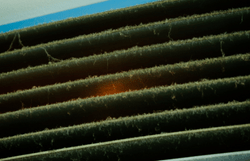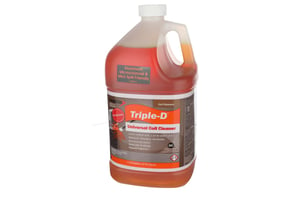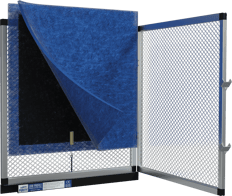Almost without knowing it, global consciousness has converged on one HVAC concern: indoor air quality. We usually think of pollution as smog or emissions from cars and factories, but the reality is that indoor environments can be just as, if not more, harmful.
According to the EPA, pollution levels inside — where Americans spend up to 90% of their time — can be two to five times the concentration levels of outdoor environments. In severe cases, it can even reach 100 times higher. Ironically, those who are most potentially susceptible to their effects (such as young children and senior citizens) often spend more time inside, which can exacerbate existing problems.
Signs of Poor Indoor Air Quality
Poor-quality air outside is easy to identify. From a distance, it looks hazy or cloudy, and when you get into the thick of it, it smells of chemicals, dust, ash, and other particles that get picked up and carried by the wind.
Inside, though, the signs are a little more subtle. One or two of them might seem normal, or at most the result of neglect. Air quality in the home and office has a tremendous impact on overall health, especially as we consider its effects over time. Indoor contaminants include bacteria, mold, and allergens from pests, which can cause infections or trigger asthma attacks and autoimmune responses. The signs that follow are a clear indication of poor indoor air quality.
 Persistent Dust
Persistent Dust
Excessive dust, especially around air vents, is a clear indication of poor air quality. This, in conjunction with an air filter that gets clogged within a month of changing, signals that dust isn’t being captured properly and advanced measures may be necessary.
Lingering Odors
Your nose is your most powerful ally when investigating the air quality of an indoor space. Improper circulation leads to stale or stagnant air, allowing odors from the growth of mold and bacteria to linger, both from inside the home as well as within the HVAC equipment itself. When air filtration is poor, ordinary smells tend to persist longer than they normally would. Smells from past meals should not hang around for more than a couple of hours, so odors that persist into the next day are a clear sign of an HVAC problem.
Hot and Cold Spots
You may not think of inconsistent temperature control as an air quality problem, but like IAQ, it’s linked to a poorly functioning HVAC system. If certain rooms aren’t being heated and cooled properly, there’s a good chance that they aren’t receiving proper filtration as well. This may precede or coincide with some of the signs listed above.
Humidity Related Issues
Another part affecting indoor air quality is the level of humidity. Generally, the air should fall between 30-50%, depending on the season — higher numbers for the summer, lower in the winter.
If the air is too dry, over time, you may experience itchy, dry, or cracked skin. It can also exacerbate existing conditions such as eczema.
Conversely, overly moist air can create a hospitable environment for mold, bacteria, fungi, and other contaminants you don’t want in your air space.
Health Effects of Poor Indoor Air Quality
The link between poor IAQ and adverse health effects is very well-documented. Some symptoms are more generally associated with indoor pollutants, while others are specific to exposure to certain contaminants. Effects from these can come on suddenly or take years to develop, so precaution and attention are the best policies to help prevent them.
Cold Symptoms
It’s normal to catch colds on occasion, but cold and flu symptoms that stick around for more than a week or two may be a sign that something else is at play. If those who spend a lot of time in the space are experiencing similar symptoms that improve when they’re outside or in another building, there’s a good chance that IAQ is the culprit.
Dizziness & Fatigue
Frequent occurrences of dizziness, fatigue, or headaches associated with a certain indoor space can be a sign of exposure to pollutants, including odorless gases and fumes from cleaning supplies.
 Sleep Disruption
Sleep Disruption
The link between IAQ and ease of breathing is clear, especially in individuals with compromised respiratory systems. Difficulty breathing makes falling asleep and staying asleep challenging, which results in overworked organs and sensory disruption stemming from sleep deprivation.
5 Things to Do to Improve Your IAQ
Now that we’ve explored the importance of good indoor air quality and some ways to detect stale air, we can look at how to reduce indoor air pollution.
The link between indoor air quality and HVAC systems is so strong that normally, maintenance and upgrades are sufficient to provide healthy air.
That’s why the following section outlines the steps for cleaning, disinfecting, and protecting the HVAC system, as well as taking measures to prevent air from growing polluted in the future.
Clean the AC System
It shouldn’t come as a shock but maintaining a clean air conditioner goes a long way toward improving indoor air quality.
The air conditioner is responsible for circulating and ventilating air within a home or a building; in addition to causing health problems, the accumulation of dirt can cause problems with operations and efficiency. In fact, the most common issues with HVAC systems start with buildup on critical components. If left unchecked, this can lead to overheating or ice buildup, which can lead to costly repairs or even full replacement of a unit.
To help prevent this, you need to know what to clean, why, and how to do it safely.
Indoor Components
Indoors, the main things to pay attention to are the evaporator coils.
Filters that aren’t working properly allow dust and mold spores to pass through, where they find a home on the evaporator coils. When coils accumulate dirt, they lose some of their ability to absorb heat and humidity. This, in turn, leaves the air warm and moist, creating the perfect environment for pathogens like mold and mildew to grow.
Outdoor Components
Outside, you’ll need to clean the condenser coils.
Because they are outdoors, they are prone to picking up pollen, dust, and dirt from the air nearby. Every layer of dirt that builds up insulates the coils from the air that passes over them, making it difficult to cool. This causes the system to overwork itself trying to reach the desired temperature and leads to warmer temperatures inside.
Warm air holds more moisture, promoting the growth of more pathogens in the short term.
As dirt and debris accumulate, the components become harder and harder to clean, so they should be maintained regularly. In the long term, neglecting to properly maintain coils may cause the entire system to break down, which makes it impossible to maximize ventilation and lower the concentration of indoor air pollutants.
At this point, homeowners and building administrators face much higher out-of-pocket costs as the HVAC system deteriorates.
Use the Right Cleaner
In the best-case scenario, using the wrong cleaner does nothing, leaving the coils no better or worse than before.
Frequently, though, using improper materials can cause premature refrigerant leaks as a result of chemical reactions with vital components. Some of these show immediate damage, but others may go undetected until problems with the HVAC system become apparent.
Ultimately, a thorough inspection will reveal the need for replacement coils, or even of a full HVAC unit if the problem has gotten bad enough.
To make matters worse, some cleaners are only approved for use outdoors or in well-ventilated areas. Failure to comply with warning labels on cleaning products can release harmful chemicals into the air, exacerbating the problem that was supposed to be solved by cleaning the coils in the first place.
To avoid all this, we recommend Triple-D Universal Coil Cleaner.
 Triple-D is safe for use on both indoor and outdoor components, and it’s ideal for cleaning most metals including copper and aluminum. By using 75% less cleaning solution than comparable products, it saves costs by reducing the amount of product required and by extending the life of components by clearing them of a broad range of soils, as well as shielding them against rust formation.
Triple-D is safe for use on both indoor and outdoor components, and it’s ideal for cleaning most metals including copper and aluminum. By using 75% less cleaning solution than comparable products, it saves costs by reducing the amount of product required and by extending the life of components by clearing them of a broad range of soils, as well as shielding them against rust formation.
Disinfect When Necessary
Indoor air is constantly circulating, which means that if mold or bacteria start to grow, they can be blown around endlessly, causing all sorts of issues. To prevent this, evaporator coils, drain pans, and other components over which air passes should be thoroughly disinfected if they start to show signs of accumulating bacteria, mold, or other pollutants.
It’s important to note that common household disinfectants should not be used for this purpose because they contain compounds that may cause fires and damage to the system. Instead, use an EPA-registered disinfectant that kills molds, mildew, and viruses, and is meant for cleaning coils and drain pans.
Protect the HVAC System
In addition to cleaning the coils and drain pan, you’ll need to check the status of the condensate drain line.
If it gets clogged, it can cause water to build up in the drain pan, which allows microbes to grow and potentially be carried into the airflow of an otherwise clean system and cycled in through the vents. Clogged drain lines can also cause collected water to overflow, leading to water damage and mold in hidden areas, requiring costly repairs.
Preventative measures are best here, so be sure to use drain pan treatment tablets during AC maintenance service to keep sludge at bay.
Purify the Air
You can take indoor air quality a step further by installing HVAC air treatment systems, which work to eliminate pollutants as they pass through the system as well as continually disinfect the HVAC system components.
 There are several types of HVAC air treatment systems, but our favorite, the APCO-X by Fresh-Aire UV, uses rays of ultraviolet light in conjunction with a proprietary self-cleaning carbon catalyst. UVC light energizes VOCs and reduces them to water vapor, and it neutralizes microbes by destroying their DNA or RNA, preventing them from reproducing or replicating.
There are several types of HVAC air treatment systems, but our favorite, the APCO-X by Fresh-Aire UV, uses rays of ultraviolet light in conjunction with a proprietary self-cleaning carbon catalyst. UVC light energizes VOCs and reduces them to water vapor, and it neutralizes microbes by destroying their DNA or RNA, preventing them from reproducing or replicating.
When installed in an HVAC system, UVC lights are strategically placed so that circulating air flows past them, helping to eliminate contaminants while working in conjunction with the system’s HVAC filter.
Prevent Buildup
Air purifiers are good at keeping the air free from microscopic and chemical contaminants, but they can’t do much about larger particulate pollutants.
 Remember, part of the reason that bacteria can grow and disrupt coil function in the absence of UV light is that particles such as pollen, pet dander, and dust make it through the system and accumulate on coils and in the drain pan. That’s why it’s so important to have a high-quality, well-maintained filtration mechanism.
Remember, part of the reason that bacteria can grow and disrupt coil function in the absence of UV light is that particles such as pollen, pet dander, and dust make it through the system and accumulate on coils and in the drain pan. That’s why it’s so important to have a high-quality, well-maintained filtration mechanism.
One such filter is the Purity Low Profile air filter, which produces a polarized charge that attracts particulate matter to its fibers, charging them and providing more surface area for further attraction of particles.
Which One Should I Start With?
Each of these approaches contribute towards better indoor air quality for your building. If you don’t know where to start, consult with a certified HVAC contractor to help determine the best options for your needs. Taking the steps to improve your indoor air quality will not only protect the health of building occupants but also will extend the life of your system and save you money on larger system problems down the road.
